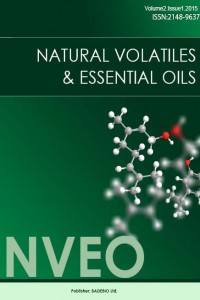Abstract
References
- Baytop, T. (1999). Therapy with Medicinal Plants in Turkey, Past and Present. 2nd ed., Istanbul, Turkey: Nobel Tıp Basımevi.
- Davis, P.H. in: Davis, P.H. (Eds) (1982).The Flora of Turkey and East Aegean Islands, pp. 42, Edinburgh, UK:
- Edinburgh Univ. Press. ESO 2000 (1999). The Complete Database of Essential Oils, the Netherlands: Boelens Aroma Chemical Information Service.
- European Pharmacopoeia, Council of Europe (2010). 7th ed., Strasbourg: European Directorate for the Quality of Medicines & HealthCare.
- Jennings, W.G., Shibamoto, T. (1980). Quantitative Analysis of Flavor and Fragrance Volatiles by Glass
- Capillary GC, New York: Academic Press. Joulain, D., Koenig, W.A. (1998). The Atlas of Spectra Data of Sesquiterpene Hydrocarbons, Hamburg: EB- Verlag.
- Koenig, W.A., Joulain, D., Hochmuth, D.H. (2004). Terpenoids and Related Constituents of Essential Oils.
- MassFinder 3. Hochmuth DH (ed). Convenient and Rapid Analysis of GCMS, Hamburg, Germany. McLafferty, F.W., Stauffer, D.B. (1989). The Wiley/NBS Registry of Mass Spectral Data, New York: J Wiley and Sons.
- Turill, W.B. (1934). The Correlatıon of Morphological Variation with Distribution in Some Species of Ajuga,
- The New Phytologist, 3, 218-230.
Abstract
Aerial parts of Ajuga laxmannii collected from five different localities in Turkey were hydrodistilled for 3 h using a Clevenger-type apparatus to produce a small amount of essential oil which was trapped in n-hexane. Oils were analysed by gas chromatography (GC) and mass spectrometry (GC/MS). The main components were as follows:Â sample A: Nonacosane (17.8%), Heptacosane (12%), Hexahydrofarnesyl acetone (11.2%); sample B: Hexadecanoic acid (21.2%), Dodecanoic acid (12.3%), Tetradecanoic acid (8.9%); sample C: Phytol (12.5%), Hexadecanoic acid (10.0%), Hexahydrofarnesyl acetone (8.6%); sample D: Hexahydrofarnesyl acetone
(9.1%), Hexadecanoic acid (8.9%), Nonacosane (7.6%); sample E: Hexadecanoic acid (13.6%), Phytol (13.3%), Hexahydrofarnesyl acetone (8.3%).
Keywords
References
- Baytop, T. (1999). Therapy with Medicinal Plants in Turkey, Past and Present. 2nd ed., Istanbul, Turkey: Nobel Tıp Basımevi.
- Davis, P.H. in: Davis, P.H. (Eds) (1982).The Flora of Turkey and East Aegean Islands, pp. 42, Edinburgh, UK:
- Edinburgh Univ. Press. ESO 2000 (1999). The Complete Database of Essential Oils, the Netherlands: Boelens Aroma Chemical Information Service.
- European Pharmacopoeia, Council of Europe (2010). 7th ed., Strasbourg: European Directorate for the Quality of Medicines & HealthCare.
- Jennings, W.G., Shibamoto, T. (1980). Quantitative Analysis of Flavor and Fragrance Volatiles by Glass
- Capillary GC, New York: Academic Press. Joulain, D., Koenig, W.A. (1998). The Atlas of Spectra Data of Sesquiterpene Hydrocarbons, Hamburg: EB- Verlag.
- Koenig, W.A., Joulain, D., Hochmuth, D.H. (2004). Terpenoids and Related Constituents of Essential Oils.
- MassFinder 3. Hochmuth DH (ed). Convenient and Rapid Analysis of GCMS, Hamburg, Germany. McLafferty, F.W., Stauffer, D.B. (1989). The Wiley/NBS Registry of Mass Spectral Data, New York: J Wiley and Sons.
- Turill, W.B. (1934). The Correlatıon of Morphological Variation with Distribution in Some Species of Ajuga,
- The New Phytologist, 3, 218-230.
Details
| Primary Language | English |
|---|---|
| Journal Section | Research Article |
| Authors | |
| Publication Date | April 3, 2015 |
| Published in Issue | Year 2015 Volume: 2 Issue: 1 |

